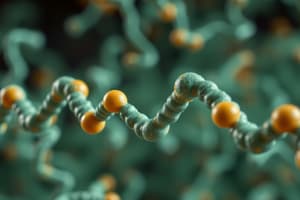Podcast
Questions and Answers
What are carbohydrates primarily made of?
What are carbohydrates primarily made of?
- C, H, O, N, P
- C, H, O, N
- C, H, O (correct)
- C, H
Which of the following are functions of carbohydrates? (Select all that apply)
Which of the following are functions of carbohydrates? (Select all that apply)
- Structure (correct)
- Energy storage (correct)
- Quick energy (correct)
- Hormone signaling
What are the types of sugars?
What are the types of sugars?
- Glucose
- Fructose
- Sucrose
- All of the above (correct)
What are proteins?
What are proteins?
Which of the following are functions of proteins? (Select all that apply)
Which of the following are functions of proteins? (Select all that apply)
What are the building blocks of proteins?
What are the building blocks of proteins?
What distinguishes hydrophobic amino acids?
What distinguishes hydrophobic amino acids?
What distinguishes hydrophilic amino acids?
What distinguishes hydrophilic amino acids?
What are lipids?
What are lipids?
Which of the following is NOT a function of lipids?
Which of the following is NOT a function of lipids?
What are saturated fats typically derived from?
What are saturated fats typically derived from?
Which type of fats are considered better for health?
Which type of fats are considered better for health?
What are nucleic acids?
What are nucleic acids?
What are the functions of nucleic acids? (Select all that apply)
What are the functions of nucleic acids? (Select all that apply)
What are the five different nucleotides?
What are the five different nucleotides?
What is unique about water?
What is unique about water?
What does the periodic table of elements show?
What does the periodic table of elements show?
Which property of water indicates that ice is less dense than liquid water?
Which property of water indicates that ice is less dense than liquid water?
What elements make up lipids?
What elements make up lipids?
Which elements are found in nucleic acids?
Which elements are found in nucleic acids?
What elements do proteins contain?
What elements do proteins contain?
Flashcards are hidden until you start studying
Study Notes
Carbohydrates
- Serve as building block molecules primarily in the form of sugars.
- Functions include providing quick energy and energy storage, as well as contributing to structural components in cells.
- Types of sugars include glucose, fructose, sucrose, and maltose.
Proteins
- Known as multipurpose molecules, essential for various biological functions.
- Functions include hormone signaling (e.g., insulin), muscle movement, immune response, and acting as enzymes to facilitate chemical reactions.
- Comprised of amino acids, with 20 different types available for protein synthesis.
Amino Acids
- Formed into polymers through peptide bonds; each has distinct properties.
- Can be classified based on their affinity for water; hydrophilic amino acids are water-loving and hydrophobic amino acids are water-fearing.
Lipids
- Concentrated energy molecules, storing energy efficiently with double the energy yield compared to carbohydrates.
- Functions include energy storage, forming cell membranes, providing insulation, and cushioning organs.
- Types include saturated fats (solid at room temperature and linked to heart disease) and unsaturated fats (liquid at room temperature and healthier).
- Cholesterol plays a vital role in cell membranes and hormone synthesis, though excess levels can be detrimental.
Nucleic Acids
- Information molecules, key in genetics, consisting of DNA and RNA.
- Functions include storing genetic material, acting as a blueprint for protein synthesis, and transferring information.
- Made up of nucleotides, which possess different nitrogen bases: A, T, C, G (DNA) and U (RNA).
Water
- Exhibits polarity due to the unequal distribution of electrons, making it a good solvent for charged and polar molecules.
- Unique properties include ice being less dense than liquid water and a high heat of vaporization, contributing to temperature regulation in living organisms.
Elemental Compositions
- Carbohydrates consist of carbon (C), hydrogen (H), and oxygen (O).
- Lipids are composed of carbon (C), hydrogen (H), and oxygen (O).
- Nucleic acids contain carbon (C), hydrogen (H), oxygen (O), nitrogen (N), and phosphorus (P).
- Proteins consist of carbon (C), hydrogen (H), oxygen (O), nitrogen (N), and occasionally sulfur.
Studying That Suits You
Use AI to generate personalized quizzes and flashcards to suit your learning preferences.




